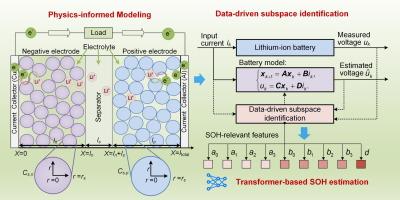Unified physics-informed subspace identification and transformer learning for lithium-ion battery state-of-health estimation
IF 14.9
1区 化学
Q1 Energy
引用次数: 0
Abstract
The growing use of lithium-ion batteries in electric transportation and grid-scale storage systems has intensified the need for accurate and highly generalizable state-of-health (SOH) estimation. Conventional approaches often suffer from reduced accuracy under dynamically uncertain state-of-charge (SOC) operating ranges and heterogeneous aging stresses. This study presents a unified SOH estimation framework that integrates physics-informed modeling, subspace identification, and Transformer-based learning. A reduced-order model is derived from simplified electrochemical dynamics, providing an interpretable and computationally efficient representation of battery behavior. Subspace identification across a wide SOC and SOH range yields degradation-sensitive features, which the Transformer uses to capture long-range aging dynamics via multi-head self-attention. Experiments on LiFePO4 cells under joint-cell training show consistently accurate SOH estimation, with a maximum error of 1.39 %, demonstrating the framework’s effectiveness in decoupling SOC and SOH effects. In cross-cell validation, where training and validation are performed on different cells, the model maintains a maximum error of 2.06 %, confirming strong generalization to unseen aging trajectories. Comparative experiments on LiFePO4 and public LiCoO2 datasets confirm the framework’s cross-chemistry applicability. By extracting low-dimensional, physically interpretable features via subspace identification, the framework significantly reduces training cost while maintaining high SOH estimation accuracy, outperforming conventional data-driven models lacking physical guidance.

锂离子电池健康状态估计的统一物理信息子空间识别和变压器学习
锂离子电池在电力运输和电网规模存储系统中的应用越来越广泛,这就增加了对准确和高度一般化的健康状态(SOH)估计的需求。在动态不确定荷电状态(SOC)工作范围和非均匀老化应力下,传统方法的精度往往会降低。本研究提出了一个统一的SOH估计框架,该框架集成了物理信息建模、子空间识别和基于transformer的学习。从简化的电化学动力学中导出了一个降阶模型,提供了一个可解释和计算效率高的电池行为表示。在广泛的SOC和SOH范围内的子空间识别产生了退化敏感特征,Transformer利用这些特征通过多头自关注来捕获长期老化动态。在LiFePO4电池上进行的联合训练实验表明,该框架在解耦SOC和SOH效应方面是有效的,最大误差为1.39%。在跨细胞验证中,在不同的细胞上进行训练和验证,模型保持了2.06%的最大误差,证实了对未见过的衰老轨迹的强泛化。在LiFePO4和公共LiCoO2数据集上的对比实验证实了该框架的交叉化学适用性。该框架通过子空间识别提取低维、物理可解释的特征,显著降低了训练成本,同时保持了较高的SOH估计精度,优于缺乏物理指导的传统数据驱动模型。
本文章由计算机程序翻译,如有差异,请以英文原文为准。
求助全文
约1分钟内获得全文
求助全文
来源期刊

Journal of Energy Chemistry
CHEMISTRY, APPLIED-CHEMISTRY, PHYSICAL
CiteScore
19.10
自引率
8.40%
发文量
3631
审稿时长
15 days
期刊介绍:
The Journal of Energy Chemistry, the official publication of Science Press and the Dalian Institute of Chemical Physics, Chinese Academy of Sciences, serves as a platform for reporting creative research and innovative applications in energy chemistry. It mainly reports on creative researches and innovative applications of chemical conversions of fossil energy, carbon dioxide, electrochemical energy and hydrogen energy, as well as the conversions of biomass and solar energy related with chemical issues to promote academic exchanges in the field of energy chemistry and to accelerate the exploration, research and development of energy science and technologies.
This journal focuses on original research papers covering various topics within energy chemistry worldwide, including:
Optimized utilization of fossil energy
Hydrogen energy
Conversion and storage of electrochemical energy
Capture, storage, and chemical conversion of carbon dioxide
Materials and nanotechnologies for energy conversion and storage
Chemistry in biomass conversion
Chemistry in the utilization of solar energy
 求助内容:
求助内容: 应助结果提醒方式:
应助结果提醒方式:


